Every now and then I receive a letter in the office that just stirs me and gives goosey bumps. The following is one of those electric memos. The writer’s quandary is a mystery for all those Hanscom Park Neighborhood kiddies of long ago, Omaha sleuths who perpetually burn the midnight oil and anyone who treasures a good folklore-filled puzzler. It’s a local haunted legend about a rumored witch in Hanscom Park and we need your help. With her permission, I share the writer’s letter because I believe someone out there holds the historical clue and many more might remember a portion of this eerie children’s oral history.
“Dear Miss Cassette,
When I was a child I lived at 2229 Hanscom Blvd near Hanscom Park. I was born in 1959. When I was 10 years old, there were stories about an old lady that lived in Hanscom Park in a cabin at the backside–on the Park Avenue side. They called her “the Hanscom Park Witch.” She lived in it, kind of like a caretaker of the park. People told me the lady practiced witchcraft and that kids disappeared. I heard that she died in the cabin when some teen boys set it on fire. This happened long before I was born. The reason I wanted to know is, I had a paranormal experience there when I was 10 and it has stuck with me for over 50 years.
Back then after the cabin was gone, Hanscom Park always had that section of the park roped off and told us never to go back there but being a curious child, I went under the ropes. There was still evidence of some old burned logs on ground that had been there for a long time and the old campfire pit with large rocks around it. There was no building left. What I found odd was the outside temp was 101 but back in the roped off area it felt like 30 degrees. It was freezing back there. It made no sense to me. Then when I was standing there, it felt like something cold went right through me. It scared me so much I ran home and never went back to that part of the park.
In my reading up I found originally there was a Boy Scout cabin at Hanscom Park in early 1900’s. I know the cabin was presented to the Boy Scouts in the early 1900’s. I think I saw an article about that, which I’m still trying to find. It made the newspaper that someone important dedicated it to the Scouts. So here’s my dilemma. I want to know about this lady and the cabin that burned down. This incident was very upsetting to me as a child and never have experienced anything like that. Ever since that day I’ve followed paranormal, tried to research the cabin and the story, but no luck.
Thank you,
Karil Mobley”
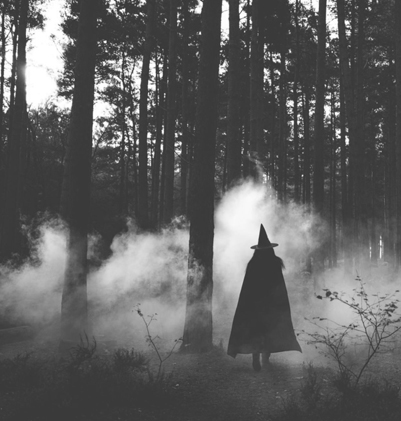
Karil’s Clues
My hinky meter did not go off, in fact, the more I communicated with Karil, I knew she was coming from an authentic place. I understood right away that this was a frightening, inexplicable experience to her. Now you can understand why I was all goosey. My friend Jimmy, who lives in the Hanscom Park-Field Club Neighborhood, asked his friend, Gene, about the Hanscom Park Witch, as this gentleman also grew up in the area. Gene reported a similar witch’s cabin storyline from his childhood and he remembered the roped-off area, which at the very least, validated there was a local legend within the neighborhood. I was fascinated. But how to track a folk tale to its origin? Questions arose quickly for me, such as what was a Boy Scout cabin anyway? When did the cabin burn down? How and why was this area roped off? Did other people sense the energy in that corner of the park? There were more details gleaned from Karil in our back and forth communication; she was able to answer as best she could from her child’s mind. I knew you Sherlocks would want to know these things too.
-To Karil’s memory, the cabin was situated in the flat area in the very northeast corner of the park—the corner of Woolworth and Park Avenues.
–“The cabin sat with a fire pit in front in the wooded part of the park.” She said that specific area of the park “was more wooded in 1969.” The cabin burned down in the early 1900s to 1930s. She remembered she heard it was originally a Boy Scout cabin when first built.
-I was curious to know if the roped off area was temporary, like in the case of an accident or more of a formal plan with stations and chains? Karil remembered there being “some kind of twisted rope around the area with a sign saying, ‘Stay out of this area.’ The rope had been there for as long I can remember.”
I found Karil to be a good historian and genuinely passionate in our exchanges. Her history of family homes and her early life experiences on Hanscom Blvd and 13th Street matched public records. It also shed light on her child’s world view, which I always crave to understand. I share these further details with her permission.
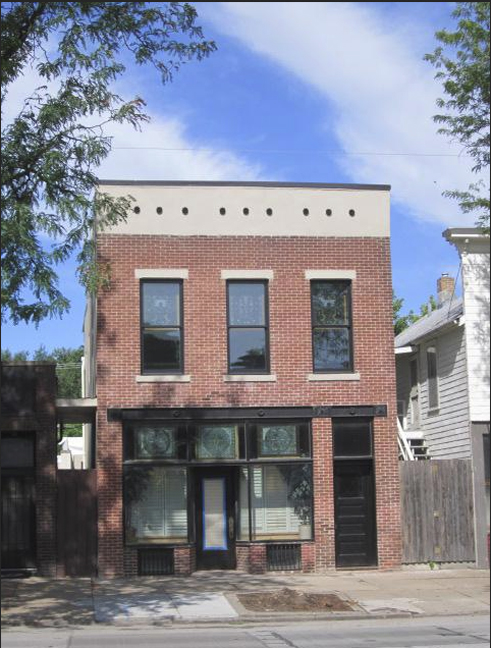
1420 South 13th Street photograph borrowed from the Douglas County Assessor site.
“We moved from 1420 South 13th Street when I was five. My grandfather bought the (13th Street) building in the early 1900’s after being a bakery. We lived in the apartment upstairs and the bakery downstairs was turned into Welders Products. My grandfather was a blacksmith and welder and my father was also a welder. I grew up knowing everyone on 13th Street. The family owned the shop for 100 years.
I grew up knowing everyone on 13th Street. I knew the Kapouns, who owned Bohemian Café. Next to them was Frank’s Barber Shop. Next to him Baxter’s Saw Shop. Next to our place, Rudy Dworak Stained Glass Shop and Charlie’s Candy Store and Soda Shop next to us. I also knew the Marinos who owned Marino’s grocery store and Masek’s Bakery, who had the best cream puffs I’ve ever tasted in my life and Ethic Sandwich Shop the used to be Dairy Queen. I used to go there with my grandpa to get butterscotch dipped ice cream cones and Donut King–the best donuts in town.”
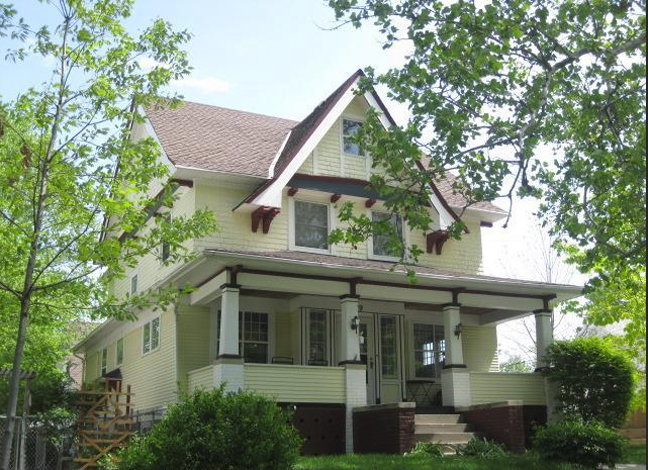
2229 Hanscom Boulevard photo borrowed from the Douglas County Assessor site. The Mobleys moved to this gorgeous home from the super cool 13th Street location when Karil was young.
“My older neighbor lady, long passed away, would tell me stories. She told me the house we lived in was the house of the builder and architect of the Hanscom Park Subdivision. This was the first house built by him and it’s now over 100 years old. Weird things always happened in our house–I was always afraid of the basement and attic.”
My Stake Out
A day later, I went to the area of Hanscom Park that Karil remembered as being cordoned off–once site of the rumored witch’s cabin. Now I will admit this corner of the park has always intrigued me. Hanscom Park seemed dark and suspicious in the 80s and 90s and this corner, in particular, was an overgrown no man’s land. However I’ve got it from a good source that this hidden range served as a spot for sexual encounters in the 70s and 80s, maybe earlier. The trees and foliage were thick and inky; it was a dense, sightless vision from the street side corner of Park Avenue and Woolworth. If you remember from my earlier story on Hanscom Park, (The Case of Park Avenue and the Mysterious Hospital) this very drop off corner has always given me a terrifying thrill. In high school none of us who ventured to Hanscom Park were from the surrounding neighborhood. With its rolling hills and deep basin, it was a place full of mystery, cut off from home or the outside world, at least after dark. Much like Elmwood Park, it was an infrequent spot with our group—a place to drink, smoke and play music. But because of its great hiding places, it seemed to draw in both teens and the types of adult characters needing refuge. Not a good combination. It felt fraught with unknown dangers–which only led to more teenage imagination run riot.
But on this fall day, I wanted to try to dig around, get a feel for the place and take some photos for Karil. I found my job was much easier than I suspected because the wood is very much cut back compared to how I remembered it. A disc golf course rambles through this now sunny portion of the park. It was early on a Monday morning and there was a lone college age kid playing disc golf himself. I felt fairly safe to be down there alone and I told myself, I am an adult now. (The kid might have thought I was the witch.) Unfortunately I could not find any real remnants of what Karil had described. This would have all been cleaned up for the current course. I did find the area where a cabin could have been, although it seemed built-up at an angle and filled in with soil. Unless I am remembering it wrong, it used to be a sharper drop off from street level.
- Camera facing northeast corner. Woolworth Avenue and Park Avenue above.
- Detail of the corner.
- Camera facing east. Park Avenue above. Park North and South Towers in the distance.
- Camera facing west, into Hanscom Park.
I sent one of the photos to Karil. She wrote back: “So I see you seem to be in the right area near the logs but when I was kid there were large stones around in a circle. When I was a kid there were tons of trees back there–more like forest. It was very secluded back there. You could not see the streetlights or fence at the time. There were also pieces of burnt wood laying around that had been there for a long time.”
Karil later offered up a link to the great North Omaha History blog article “Cemeteries We Don’t Talk About.” (https://northomahahistory.com/) Adam Sasse Fletcher wrote, “Early burials also happened in present-day Hanscom Park, near the intersection of Park and Woolworth Avenues. Nobody took care of this site and it soon grew over and was generally neglected, then forgotten about.” This was very exciting and Karil and I both wondered about this stimulating clue with relation to the cabin, the witch and the energy she felt when she went under the ropes.
As you can see, there was a whole lot of lore and perplexers (new word?) to tunnel through. There was a pile up of a dead witch, rumor of her being a park caretaker, missing kids, a cabin that burned down, a mysterious cordoned off area and to top it off, a once cemetery upon which the cabin was built, in the exact same corner of the park. Guys and gals, I will admit, I chiseled and chiseled but I did not get very far, other than my own personal revelation of how very strange and mysterious Hanscom Park truly is. First off, I hope the Hanscom Park Neighborhood children of the past will share their memories of the story of the witch and the cabin. I know that would validate Karil’s memory and experience. Secondly, Karil and I ask that anyone with historic clues please come forward and confirm the existence of this cabin, the fire and the roped off area. And heck, if you can authenticate the Witch of Hanscom Park or even how this spooky story began, I will see to it that you are made Mayor of Hanscom Park, at least in the cobwebbed halls of My Omaha Obsession.
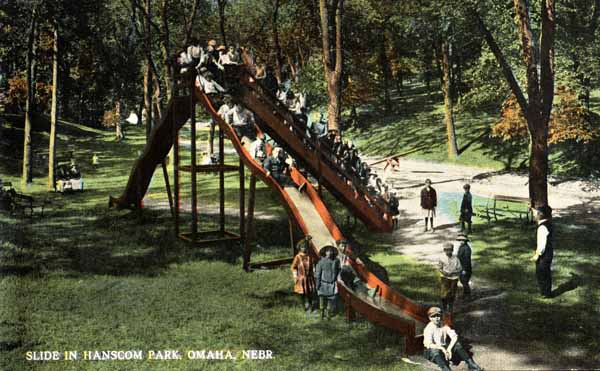
Slide in Hanscom Park postcard borrowed from Karil Mobley’s collection. She said that she remembers Hanscom Park being more wooded, like in this mesmerizing image.
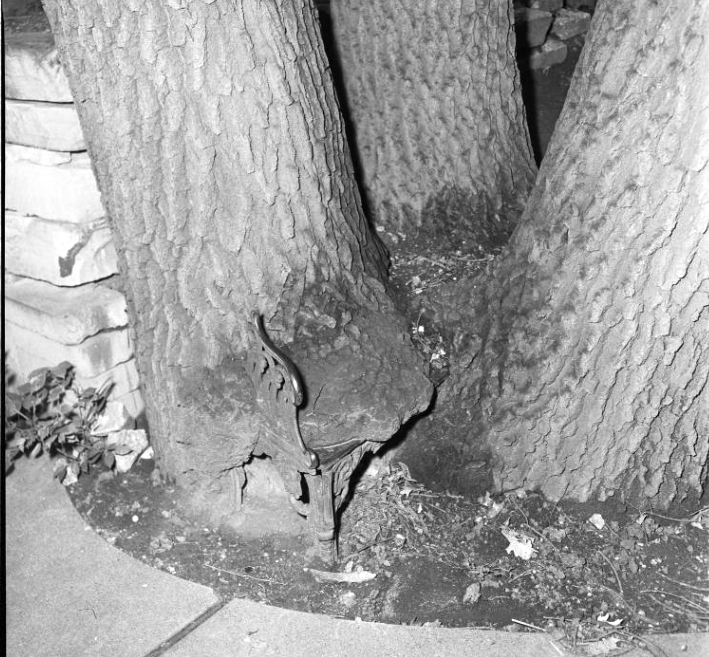
Just a part of the wonderful strangeness of Hanscom. The hungry tree that ate Hanscom Park’s iron bench from the 1800s. Creator: Paskach, Robert (1927-2001). Publisher: The Durham Museum. Date: August of 1955.
Early Excavation
For those impatient sorts, I will tell you, I could not solidly locate a Boy Scout cabin. I would find a number of historic buildings within the park grounds, which I will describe in a bit. I would scour all of the historic photos I could get my hands on, page through all of my Omaha books and sniff around in all of the archival papers looking for this cabin. I involved the Real Pros of Snoop, Martha Grenzeback and Lynn Sullivan, librarian sleuths of the downtown W. Dale Clark Library. After thunking my head against a library wall for a good long while, I called the City of Omaha Parks, Recreation and Public Property Department at Martha Grenzeback’s suggestion. I left a message with Dennis, apparently a 30-year employee with the Omaha parks, but I have not yet heard back from him regarding the once cabin. I dreamed Dennis had glorious maps, knowledge of now vanished historic buildings and park logs. (I didn’t mention the witch on his voice mail, if you were wondering.) Coincidentally, librarian Lynn Sullivan’s father, Jerry Sullivan, was an Omaha Parks and Recreation worker in the mid 1950s. When asked about this mystery, Mr. Sullivan didn’t think there had a been a cabin at Hanscom Park. Of course, according to Karil’s timeline, the cabin would have been gone by then—only a roped off area would have remained.
So let’s start in on the clues. I trust you’ve read The Case of Park Avenue and the Mysterious Hospital, (for those wanting the early history of Hanscom Park) as I won’t be delving into its origin.

Hanscom Park map from Omaha’s Historic Park and Boulevard System pamphlet. Borrowed from the W. Dale Clark Library reference desk.
Boy Scout Cabins
Friends, I will tell you, I didn’t know any of this. The Boy Scouts of America have hundreds of scout camps across the United States with each Scouting association running their own camp. Many of these camps had cabins on their property where the troops stayed overnight or held meetings. I found that some troops even helped build their own cabins with the guidance of local woodsmen. Aside from the camps, there were also many more Boy Scout cabins found in city and national parks. Often a log cabin served as the troop headquarters for local meetings and activities. For example the Papillion Boy Scouts Cabin built in 1921(still standing!) features oak logs that were cut and delivered from near the Platte River, a foundation of limestone, a green shingle roof and a stone fireplace.
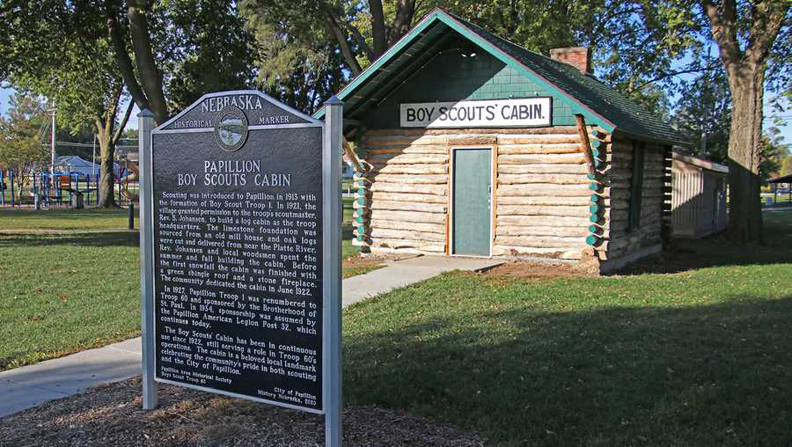
Photo of the Boy Scout Cabin borrowed from the City of Papillion.

Photo of a Boy Scout Cabin in Pennsylvania. Photo by Damien Luxe.
Librarian Lynn Sullivan informed me that the Works Progress Administration (WPA) constructed numerous Boy Scout log cabins in the 1930s as a federal relief project. This information sent me down wonderful rabbit holes with my flashlight. Gobs of scouting cabins were being built across America in this time period. Boy Scout cabins were trailed “north of Omaha,” various sprinklings across Omaha and in Lincoln. I was even able to find documentation of horrible fires in these Boy Scout cabins and vandalism by teen boys in the 1950s and 60s. It was all making sense. Of course Hanscom Park had a Boy Scout cabin, I assured myself. However, for our purposes here today, I will tell you that between the two librarians and myself, we were unable to unearth proof of a Boy Scout cabin or any kind of cabin in Hanscom Park. That does not mean it did not exist. I believe it did.

What came to be known as the lower lagoon at Hanscom Park, as there was an upper lagoon. Creator: Bostwick, Louis (1868-1943) and Frohardt, Homer (1885-1972). Publisher: The Durham Museum. Date: 1938.
I was able to find this photo of the lower Hanscom Park Lagoon. Now this little building, much like a cabin, was not described in any of the archival information on Hanscom Park and yet, here it is.

Magnified for your delight. I do not believe this is the Boy Scout Cabin, however this photo proves to me that a cabin easily could have made its way into the park without documentation.
**Addendum Oct 26, 2021** Karil saw the above photo and wrote to me. “I noticed one of the pictures of a cabin near the lagoon reminds me of the one I saw as a kid. In the winter everyone went ice skating on the lagoon. The building was a place you changed into your ice skates. They had a fire stove inside for you to warm up in there. I ice skated a lot there when I was a kid and fished in summer in the lagoon. They also had a talent show entertainment at night called the ‘Show Wagon’ that went to the parks where you could perform and win for best talent. I entered a couple of times in singing competition and ventriloquist competition.”
Other readers informed me this building was called the “skate shack.”
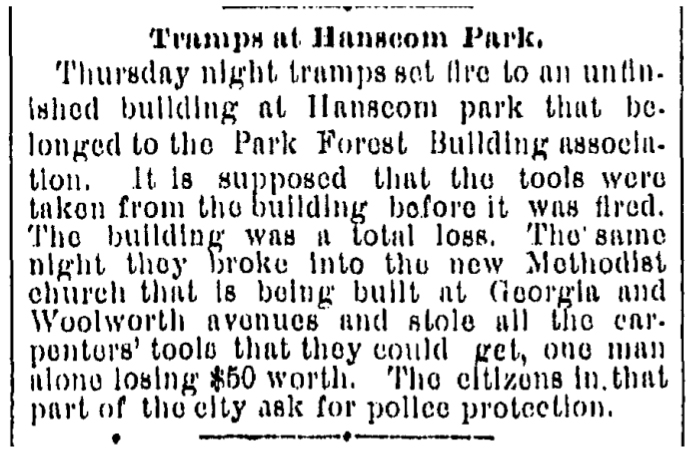
** Addendum of October 27, 2021**OWH archive. November 27, 1886: I just found this news article and it seemed to fit Karil’s story to a “T.” Did the unfinished Park Forest Building look like a cabin or a shack? Is this how the folk tale got started? The journalist neglected to mention that a witch was killed.
Is It You?
Before we move on, we’ve got an additional bit of lore to get tangled up in. My friend Jimmy lives in a house I investigated long ago– just a hop and skip from Hanscom Park. Here’s the original story if you missed it: Mysteries of Omaha: 3214 Center Street. A mysterious, rustic, log cabin with a fireplace was sitting in Jimmy’s backyard when he bought the property. Seemingly not original to the home, Jimmy has heard from his Field Club neighbors that the log cabin was moved to his backyard from Hanscom Park. He has never been able to verify this story or its true origin. In my study of the property’s historic aerial photos, the log cabin can be dated to his backyard to at least 1962. The earlier years are hazy but I think I can still make it out in 1938.

The historic mystery cabin as it appeared at 3214 Center Street.
What is Extra Omaha is that the strange and wonderful log cabin has since moved to nearby property of another house that I wrote about: 1916 South 32nd Ave. The log cabin now resides on that large stretch of land. We all want to know–is this log cabin from Hanscom Park?
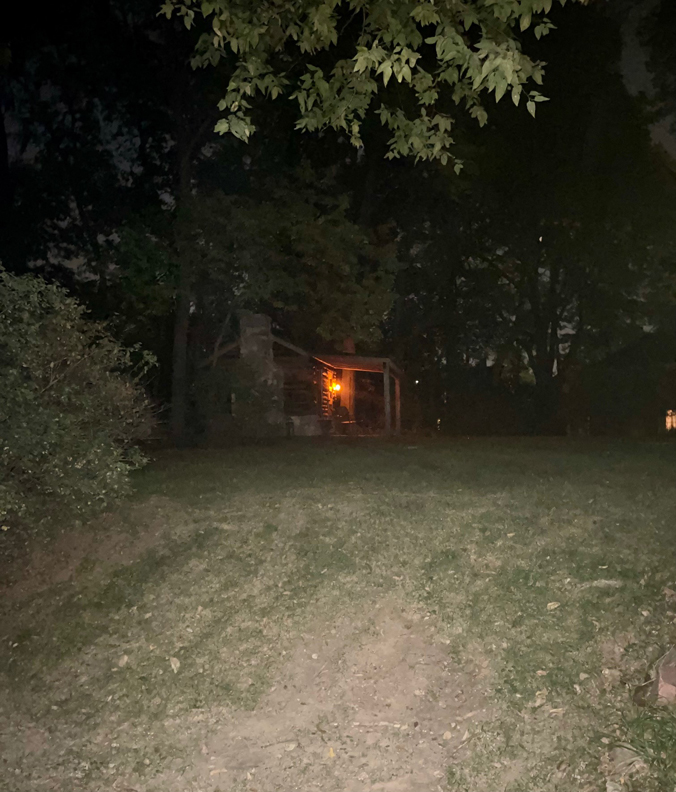
The log cabin, happy in its new home at 1916 South 32nd Avenue. AMAZING.
Hanscom Park Caretakers
Edward Francis Morearty’s book, Omaha Memories: Recollections of Events, Men and Affairs in Omaha, Nebraska, from 1879 to 1917, mentioned the park. From the 1887 to 1890 time period, “The city hired a park keeper at Hanscom, who was paid a meager salary in addition to free house rent.” This pattern of a paid caretaker living in housing (usually the pavilion) on the grounds of Hanscom Park was consistent through my search to present years. If this sounds odd, even into the late 1990s (maybe still), 15 Omaha park caretakers lived on the grounds where they worked, were on call 24 hours a day and maintained 16 city parks. In 1932-1933 Dave Johnson was making $100 a month as the Hanscom Park Caretaker; Robert Dore took over the duties in 1935; By 1940 Earl Stacy was living in Hanscom Park as caretaker. I never did find a listing of a female caretaker of Hanscom Park, however when you think about it, the witch easily could have been a caretaker’s wife.
The librarians of W. Dale Clark Library found an interesting Board of Park Commissioners Report of 1908. In a section titled “The Parks,” I read, “The park contains small artificial ponds which during the winter season is patronized by many skaters. The pavilion is heated by a large fireplace, refreshments are available and the children well looked after. During the past season, the concessionaire and wife have occupied the upper story of the pavilion. The arrangement has proved very satisfactory.” The concessionaire and his wife were serving hot cocoa and looking after the kiddies in the space below their home. At least for a time, this concessionaire and his wife were serving hot cocoa and looking after the neighborhood kiddies in the lodge like space below their quarters. Did the caretakers’ family live there as well? This would hint that there were possibly many women over the years residing in the park that could have been labeled “witch.” There is also a strong connection with these pavilion-caretakers’ living quarters and Hanscom Park fires.

The contemplative Hanscom Park fountain, with the pavilion spied in the background. Photo borrowed from the Board of Park Commissioners 1908 pamphlet at the W. Dale Clark Library reference desk.
The Hanscom Park Buildings
In 1890 a pavilion, bandstand and greenhouse were built for Hanscom Park for 32 thousand dollars. Three years later, a horrible fire claimed the first pavilion. Then in 1894, a replacement was built for $14,028. The two-story, open-air pavilion was said to overlook the water and housed concessions, a dance floor and meeting room. The caretaker had quarters above. This structure then burned down December 19, 1927.
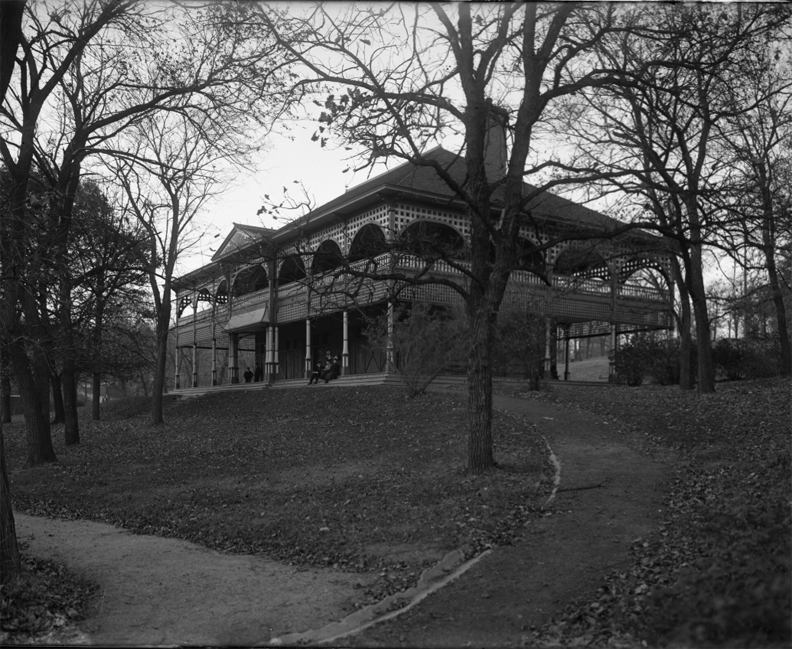
The Hanscom Park Pavilion. It had a large wrap-around porch and balcony and is partially blocked by trees. There are people sitting on the steps of the pavilion. There is part of a path in the bottom left corner. Creator: Bostwick, Louis (1868-1943) and Frohardt, Homer (1885-1972). Publisher: The Durham Museum. Date: Fall of 1913.
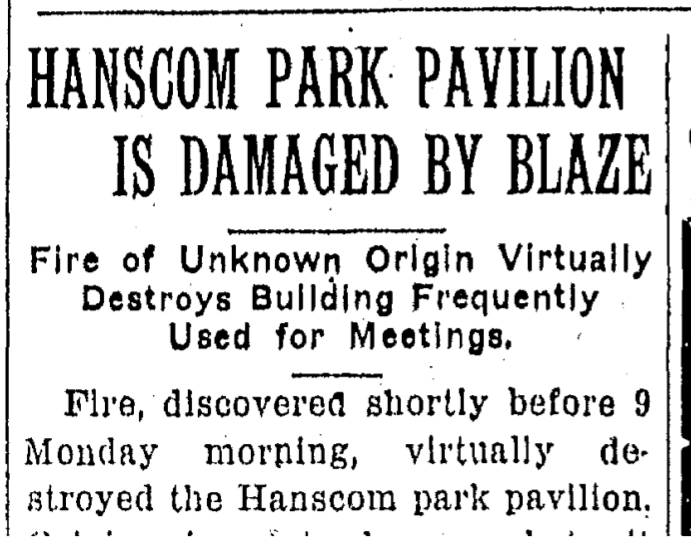
OWH archive. December 20, 1927. Cause of fire unknown.
In 1928 the new Hanscom Park “clubhouse and pavilion,” an enclosed building, was opened in November with two hundred residents of the district in attendance. Mayor Dahlman spoke, among Hanscom Park locals, who all hoped this pavilion would bring back the neighborliness of the neighborhood.
Additional greenhouses were added to Hanscom Park in 1913. The Joslyn Conservatory, an ornamental greenhouse, was donated by Sarah Joslyn, and moved from the Joslyn Castle site to Hanscom Park, following the 1913 tornado. Included in the donation were Mrs. Joslyn’s rare collection of orchids and tropical plants. Mrs. Joslyn was said to often visit Peter M. Jensen, Hanscom Park gardener, to talk and gather information about flowers. His name will come up again in this article. That same year two old greenhouses were rebuilt and a new one was constructed. The greenhouses of Hanscom Park provided (still do!) Omaha parks and boulevards with plants and flowers.

Detail of the Joslyn Conservatory, seen in the distance. Creator: Bostwick, Louis (1868-1943) and Frohardt, Homer (1885-1972). Publisher: the Durham Museum. Date: 1917.
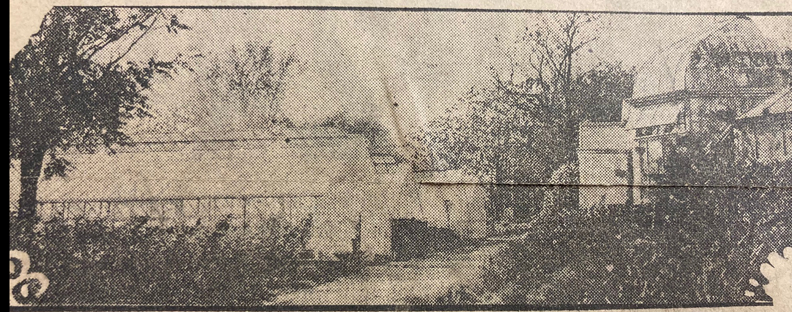
OWH Nov 1924. The Hanscom Park greenhouses. Clipping borrowed from the W. Dale Clark Library reference desk.
During World War II (in 1942) the Hanscom Park greenhouses were put up for rent when the city was attempting to “trim the frills from the park department program.” The intention was to lease the “six-section greenhouse plant” for commercial use. But by 1950 Hanscom had again taken the reins of their buildings– “a complete renovation of the greenhouse and conservatory are now in process of completion.”
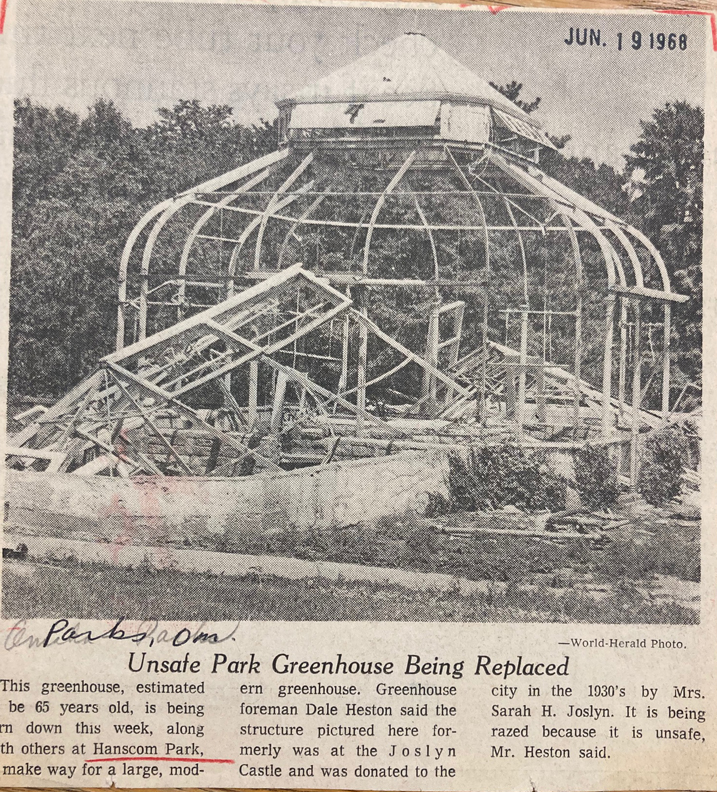
OWH. June 19, 1968. Clipping borrowed from the W. Dale Clark Library reference desk. Sadly Sarah Joslyn’s beautiful conservatory was razed in the summer of 1968, after it was deemed “unsafe.” The other greenhouses were torn down as well. The article stated Mrs. Joslyn donated her ornamental house in the 1930s. Would the park service have worked a little harder to restore the gift had they known it was donated in 1913? Probably not. We do like to make way for the new and improved here in Omaha. I began to wonder though…the time line was accurate for little Karil Mobley to have been about ten years old. Was this area cordoned off from the neighborhood children? I realize that the Joslyn Conservatory was not located in the woods but I also know how memories migrate.
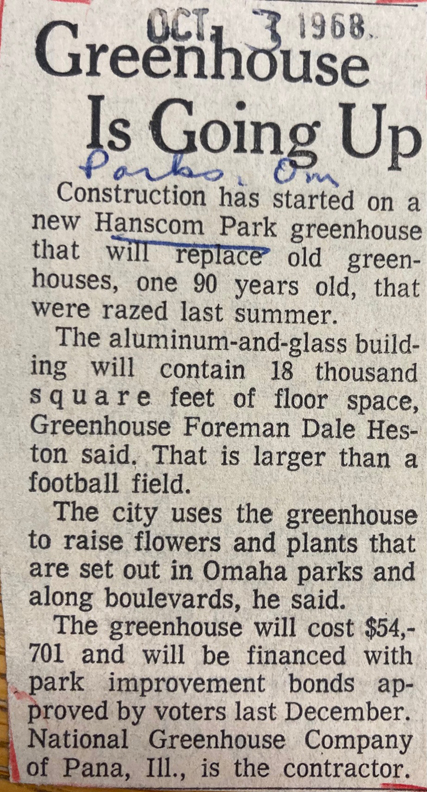
OWH. October 3, 1968. Clipping borrowed from the W. Dale Clark Library reference desk. New greenhouse being built to replace “old greenhouses, one 90 years old, that were razed last summer.” Librarian Lynn Sullivan seemed to remember a fire in the Hanscom Park greenhouse or big garage “at 32nd and Ed Creighton in the mid 1970s.” To her recollection, it too was destroyed by fire.
The circular bandstand, mentioned earlier as being built in 1890, became the scene of many a mid-Sunday afternoon concerts. But it had vanished by a 1962 article from the World-Herald. I was able to track its demise described in a 1950 progress report from the Park and Recreation Commission. “The old bandstand, which was declared unsafe, was removed.” So that’s what happened to that lovely little structure. Hey, at least it didn’t burn down.

The Hanscom Park bandstand. Creator: Bostwick, Louis (1868-1943) and Frohardt, Homer (1885-1972). Publisher: The Durham Museum. Date: 1901.
(Warning—Not at all Related to the Witch of Hanscom Park)
While we’re here and all feeling quite miserable about the destruction of beautiful park structures only to be replaced by ugly buildings, let’s burrow deeper into melancholy. There was once a picturesque upper lagoon with “lush lily pads, foot-long goldfish and rustic footbridge.” The water of the upper lagoon cascaded eastward into the bigger, lower lagoon, a portion of which still remains.
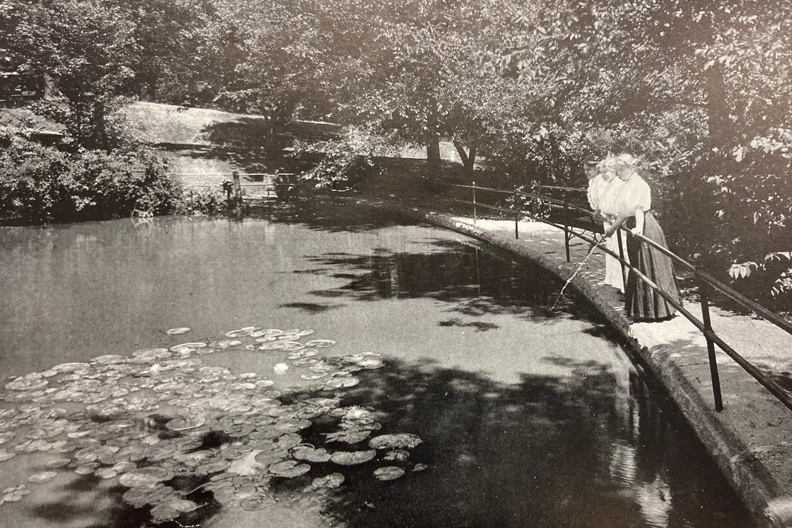
Historic image of the upper lagoon from the 22nd Annual Report of the Board of Commissioners. 1911.Image borrowed from the W. Dale Clark Library reference desk.
The yearly report from the Omaha Park Commission of 1950 revealed this about Hanscom Park: “A new roof was placed on the pavilion. The old upper lake ravine was filled and it is to be landscaped for additional park facilities.” It would seem that they were all about improvements without much foresight in the 1950 plan. Further digging reveals the upper lagoon was unused and “partly filled” by the mid 1940s. An article from 1946 stated, “the (upper) lagoon has been neglected by the Department in charge…if properly maintained the lagoon would be an added beauty to our park system and benefit to all the residents of Omaha.” At that time a natural spring in the southwest corner of Hanscom Park was rerouted into the sewer. This spring was “plugged” shortly after. Hanscom Park boasted of its “artesian wells, whose water was as highly prized as the cool liquid bubbling from Elmwood’s publicized springs.” I was most impressed with the Hanscom Park neighborhood who fought the good fight with the city department to keep their park original, unique and functional. The neighborhood took on Park Commissioner Roy Towl when he began filling the lower lagoon without warning. Judges were involved, restraining orders issues. It was wild!
Hanscom Park Cemetery?
I discovered John W. Newell, thought to be one of Omaha’s earliest white settlers. He arrived to Omaha by steamboat in 1857. Upon arrival, Newell worked in a brickyard and a year later was farming very near what is now Hanscom Park. The surrounding area was farmland. I only bring this up because I had assumed, from previous research that when Andrew Hanscom and James Megeath donated their 50-acre property, later developed into the city park, that it, too, was rural countryside. I suppose it is neither here nor there, as cemeteries are very often found in the country. An enterprising fellow, Newell later opened a livery stable and in 1862 started the first bakery in Omaha. He died at the age of 90, in 1927.
Librarian Martha Grenzeback came across this interesting clue from “Where Lie a City’s Dead” from the Omaha Daily Bee, July 19, 1896. “Still another of the cemeteries which has erased to be was located three or four blocks northeast of the present Hanscom Park, in what is now known as Shull’s Addition to Omaha.”I would find all additions of Shull’s developments between the boundaries of Pacific, 20th Street, Center and 27th Street. Likewise Alfred Rasmus Sorenson’s Early History of Omaha or Walks and Talks Among the Old Settlers from 1876 does not mention the area of Hanscom Park as being early burial ground—although it does, interestingly, tip that property just north of the Old Market was Indian burial ground. One would think that when landscape architect H.W.S. Cleveland began extensively designing and excavating the Hanscom Park land, they would reported if they found remains and burial grounds BUT maybe not. I could find no proof of a cemetery ever having been located on the Hanscom Park grounds, although a cemetery was located, apparently, a short jaunt northeast a few blocks. That being said, I have got to assume that at least one person has been covertly buried at Hanscom Park in its almost 150 year history. These are just my dark three am thoughts.

Autumn in Hanscom Park. A man on a park bench contemplates the park as a burial ground. Creator: Bostwick, Louis (1868-1943) and Frohardt, Homer (1885-1972). Publisher: The Durham Museum. Date: 1912.
Death and the Strange in Hanscom Park
In 1912 Joseph Sitler’s car ran over the curbing of Woolworth and Park Avenues and dropped into the heavily wooded corner of the Hanscom Park. What did he find there? Did he crash into a makeshift cabin? In that very same spot, Mrs. Houston was killed in a streetcar accident in 1913. Miss Daisy Blair drank poison at the corner of Woolworth and Park Avenues in May of 1919. Some of us might argue that if we go far enough back, we will find many strange, perilous occurrences happening on any corner.
Julius Meyer was found dead in Hanscom Park on May 10, 1909. He was discovered with two bullets wounds in the chest and in the head. His death was officially recorded as suicide, although this is a point of mystery and argument. Julius, who never married, was a well-known Indian interpreter, said to speak at least six Siouxan dialects and was close with numerous Native American chiefs. He also founded Omaha’s first symphony orchestra and opera house, was a founder of the synagogue, now known as Temple Israel and very active in Omaha civic affairs and the Jewish community. For those who love historical fiction, check out Gerald Kopan’s amazing Magic Words: The Tale of a Jewish Boy Interpreter, the World’s Most Estimable Magician, A Murderous Harlot and America’s Greatest Indian Chief.
In December of 1931 Harry Lapidus, local philanthropist and president of the Omaha Fixture and Supply Company, was murdered–shot three times in the head in his car on the east edge of Hanscom Park.
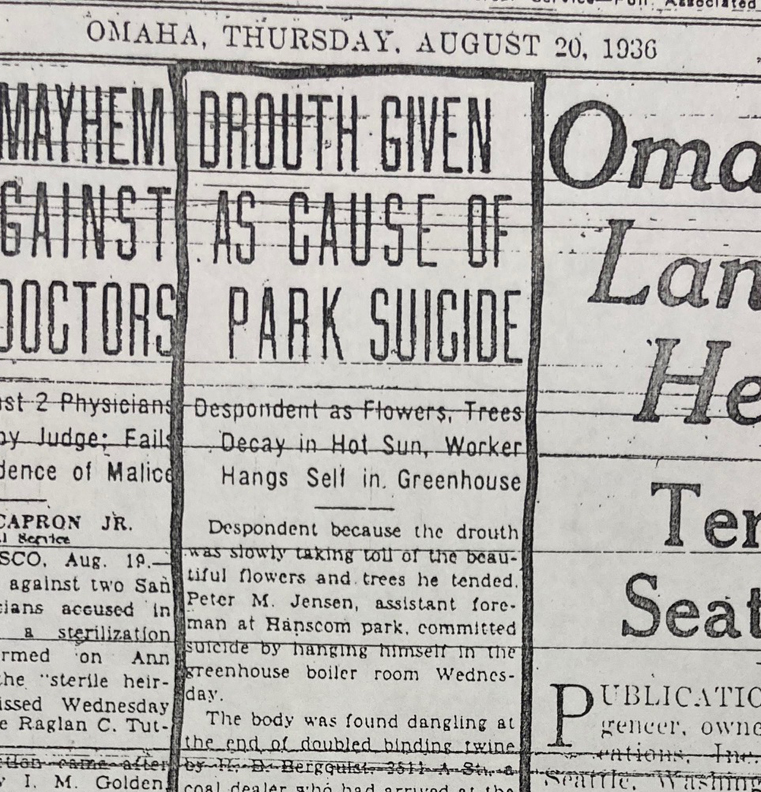
OWH archive. August of 1936. Peter M. Jensen, florist and gardener at the park greenhouse for 30 years took his own life at Hanscom Park. He was the expert, I had mentioned earlier, that Mrs. Sarah Joslyn sought out for consultation. “Yesterday illness and grief over the suffering of the flowers and trees from drought impelled him to end his life. His body was found in the boiler room of the greenhouse were he had hanged himself.” The articles were very descript, as was the custom of the day—so I will spare you. A coal dealer, who had arrived at the greenhouse seeking information about a fuel order, discovered Jensen’s body. Mr. Jensen was said to toil 10 and 11 hour days, often on Sundays. He felt that proper care of plants called for the hard work he gave to them. His wife reported when his flowers were wilting and trees burning up in the hot sun due to the drought, her husband became despondent. When he saw that many of them could not bounce back, he made his fateful decision. Born in Denmark, Jensen apprenticed to a florist at 16. He came to America at age 22.
Sleuths, I’ve wondered and I know you have also—with all of the deaths and the building fires and the excavations, did the story line of the burned down cabin and the witch caretaker begin to meld from other events over time? Another part of me believes that there are potentially many spirits roaming those rolling hills of Hanscom Park. That might explain Karil’s sensation of a cold energy moving through her when she was a child.

In the early 1900s, an average of about three hundred picnics were held in Hanscom Park each season. Times changed. A man, woman and their baby on a picnic in the fall of 1952. Creator: Paskach, Robert (1927-2001). Publisher: The Durham Museum. Date: October of 1952. Very interested to know if this was an outdoor BBQ oven, a picnic type grill or a fire pit?
Women, Witches, the Wood
I did find a number of stories that may have influenced the Witch of Hanscom Park lore. Now let it be known that I like witches, with their powers for good or ill. I have been obsessed with witches since childhood and my 70s library card history, if it could be tracked down, would prove it. (I’ve only ever known two witches and another woman that I have my suspicions of.) I am not a Doubting Dolores, but I was turning over the question–was the Witch of Hanscom Park the Omaha version of a Grimm’s Fairy Tale, wherewith mothers and grannies kept their children from wandering into the dark, hidden corners? Living in Benson, we had our own scary stories and cautionary tales but unfortunately most of them were true.
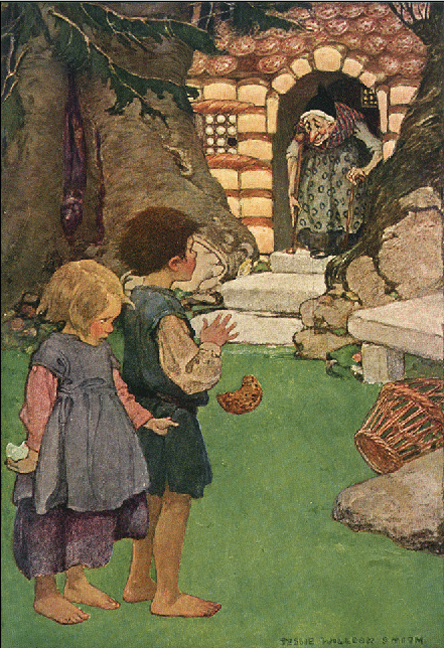
The wild woman archetype, The Old Woman in the Wood, and the wicked witch of the fairy tale forest are known internationally for their cunning and ability to align with nature in folkloric tradition. Collectively whispered about from country to country, these dangerous beings were versed in medicine and magic, the kind created from herbs and roots and stones—all things, coincidentally, found in the woods. Knowledgeable and threatening, these women turned their backs on civilization or were cast out–left to commune with the animals. The lone cabin or the hut were common dwellings in these folk tales—a rustic place of forbidden ritual and hidden ceremonies. Nestled in the forest or a wood, a popular fairy tale setting, this environment becomes a potential place of peril, far from the familiarity of the safe neighborhood or town. The unknown forest is both magical and a place of grave danger. All of these legendary, symbolic elements converge with this conniving woman of the forest, known to lure in the curious innocents or the most courageous of children, who, by the way, went against the orders of their caretakers. The older woman, the witch, feeds on youth, in some aspect, only to later use her broom to sweep away their tiny tracks up to her cabin. The Witch of Hanscom Park, interestingly, utilizes every symbolic component of this frightening tale and even includes the teen boy arsonists, acting in the best interest of the fearful community.
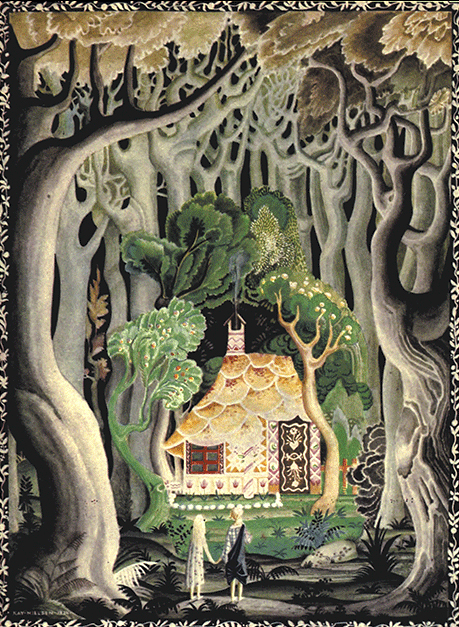
I do know, since I began this investigative business five years ago, that I have occasionally bumped into “hobo camps,” migrating people of the Depression era and other independent types who were known to set up shanties or makeshift cabins, if you will, sprinkled around town from the teens to 1940s. There were many more freedoms and not as many laws. It was also not uncommon in those days for kids to build cabins or forts and those would sometimes include a working fireplace. I only know this from my grandmother’s experience of almost setting the whole bluffs of Council Bluffs ablaze when she and her brothers were baking potatoes in their fort. The entire structure went up in flames. What if there had been an old Boy Scout cabin or a child’s fort or a loner’s shanty set up in the wooded corner of Hanscom Park? What if a wandering, unusual “witchy type” woman took up residence there in the woods? Even if she only took this home for a month, this iconic, scary story of the woman in the woods would have been activated in everyone and it would have spread like wildfire. The stuff of legends.
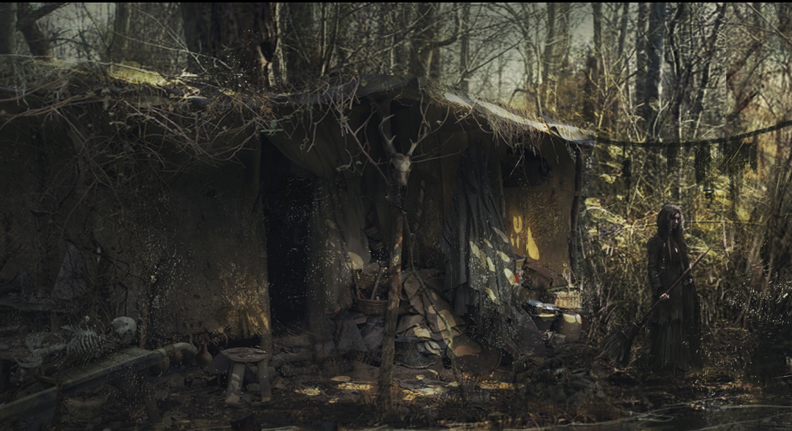
I want to thank Karil Mobley for sharing this story with me and trusting me with it. I had so much fun working on this, even though my dreams had me lost in the scary woods. Thanks to Martha Grenzeback and Lynn Sullivan of the W. Dale Clark Library for throwing their best at this investigation. If any of my detective friends can help with more clues about Hanscom Park or the witch story, we would be so grateful. This story is nowhere near completion. The case is still open.
I welcome your feedback and contributions to this Witch of Hanscom Park investigation. Any kids from the Hanscom Park Neighborhood are asked to please help us figure out this mystery. Feel free to share thoughts and clues in “Comments.” I welcome you to poke around with your flashlight. Investigate. Hide in the shrubbery. Look under these rocks and down those alleyways. I am more than pleased to have you tiptoe about. By the time you head for home, I hope you have been fully Sherlocked and Satiated. Thank you, detective friends.
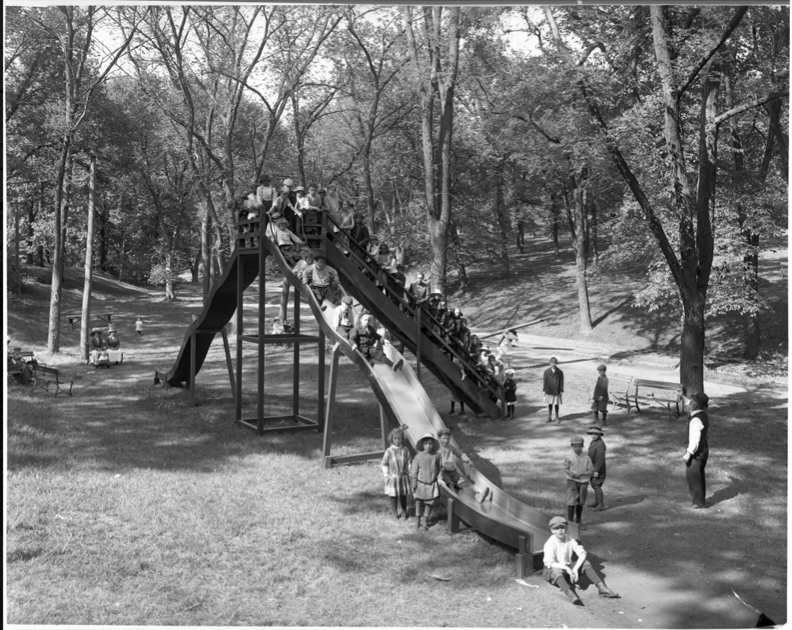
Children climbing up and sliding down a sliding board at a playground in Hanscom Park. There are some adults sitting on benches around the slide. There are also numerous trees surrounding the playground area. Creator: Bostwick, Louis (1868-1943) and Frohardt, Homer (1885-1972). Publisher: The Durham Museum. Date: May of 1913.
If you like what you see, you can keep up with my latest investigations by joining my email group. Click on “Contact” then look for “Sign me up for the Newsletter!” Enter your email address. It will then display “Thank you, your sign-up request was successful!” Make sure to check your email address to confirm. You will get sent email updates every time I have written a new article. Also feel free to join My Omaha Obsession on Facebook.
© Miss Cassette and myomahaobsession, 2021. Unauthorized use and/or duplication of this material without express and written permission from this site’s author and/or owner is strictly prohibited. Excerpts and links may be used, provided that full and clear credit is given to Miss Cassette and myomahaobsession with appropriate and specific direction to the original content.
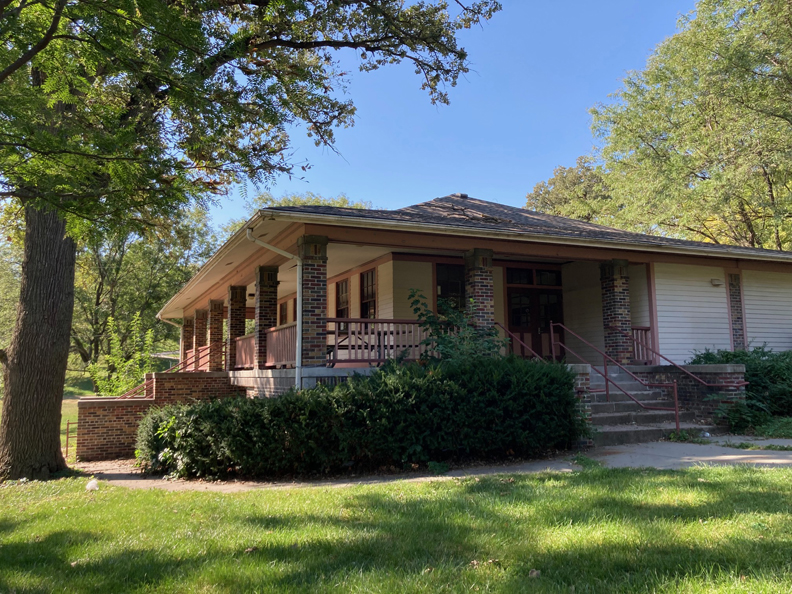
Current Hanscom Park pavilion.
If you are looking for more architectural and Omaha history sleuthing fun, ask your local or big box bookseller for my new book: My Omaha Obsession: Searching for the City. You can also order it through this website. Thank you.
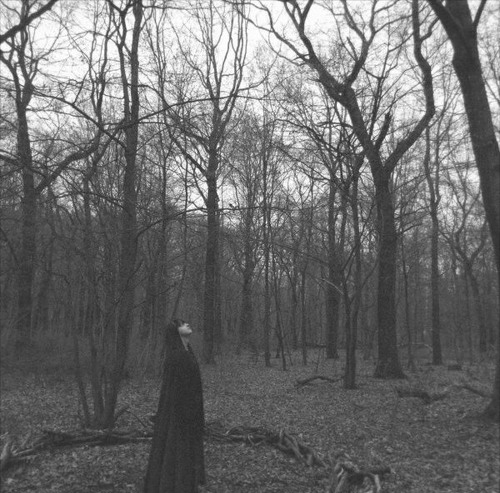
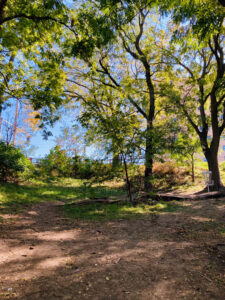

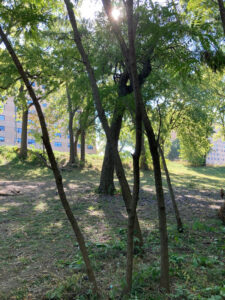
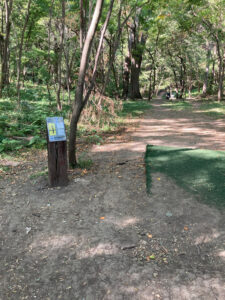
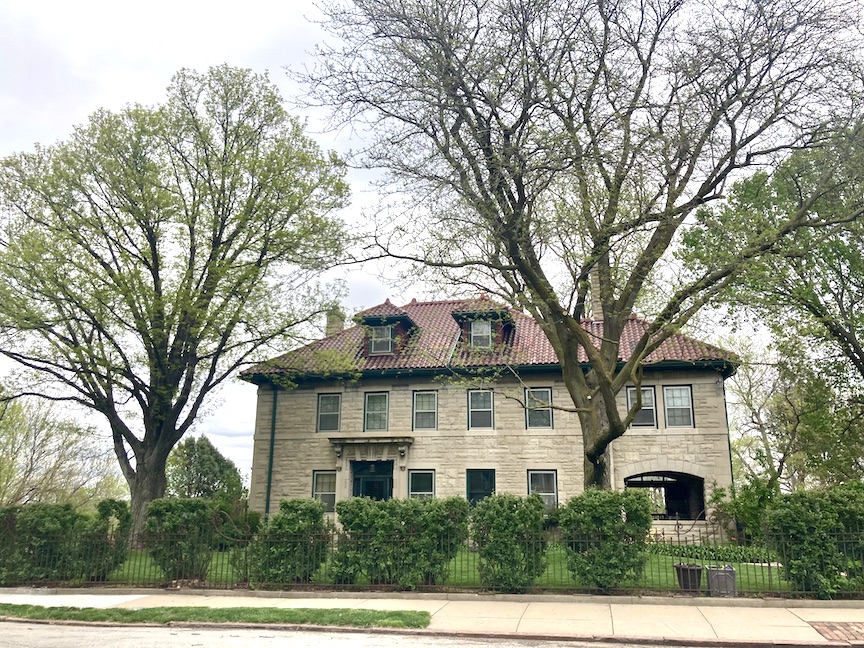
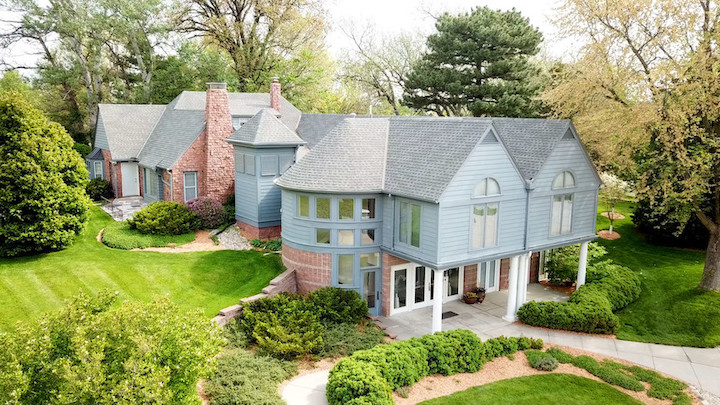
I love your sleuthing stories and writing style!
Your descriptions are intriguing to read makes me want more, and more.
Keep up the great sleuthing!
Miss Cassette,
I thank you for your work and all the amazing history you provide. My wife Nikki and I currently reside at 1916 S 32nd Ave. This is now the home to the log cabin you have referenced. I grew up at 3314 Frances Street and have many fond memories of this log cabin when it sat North of Center Street. Our neighborhood was full of children growing up in the 60-70s I knew that there were many kids who had played in and around it and didn’t want those memories to go away. I met Jim shortly after he purchased 3214 Center and learned that the log cabin was looking for a new home. Jim shared with me the thought that the cabin once lived in Hanscom Park. I plead my case that if it was not going to be returned to the Park then it should be relocated to the James Megeath’s property behind 1916 S. 32nd Ave. As I’m sure you know James Megeath donated 40% of the ground for the purpose of the Park. He build the residence we now maintain and we enjoy to learn much of his amazing history. I spoke with Jim about this and thankfully he agreed to gift the cabin to its current location. To date I have not learned the birth place of the log cabin but I do have a small world story of it.
While on vacation in the Lake of the Ozark’s Mo. We met up with some people from Omaha and I was introduced to Terry McFarland. Terry was the same age as my Dad (1936) and was raised in Omaha. We got to talking and he asked where we lived. I told him Hanscom Park… He said he grew up across the street from the park. Sure enough he lived at 3214 Center Street. I immediately asked him if he remembered a log cabin. His answer was “Yes” in our back yard! Terry stated he lived there as a young boy 1940’s and he believed the log cabin was there way before them residing on Center St. I pulled out my phone and showed him a picture of it and he just smiled.
I also learned that neighbor Dick Vaughn of Hickory Street who was born in 1933 played in the log cabin as a young boy. So the thought the log cabin had been at 3214 Center in 1938 is pretty believable.
Please keep up the great work and again Thank You!!
Jeff
I love this! Thank you so much for sharing these nuggets.
As I recall, there was a set of steep concrete stairs with a metal pipe handrail that was located on that NE corner of the park. It was indeed very overgrown and dense with trees and vegetation. My two brothers and I explored that area more than once. It was a bit scary.
The cabin that was by the lagoon was used for ice skaters to warm up.
My grandparents lived just south of the park on 32nd Ave. I remember fishing, ice skating and sledding on and near the lagoon as a small child. I do remember a lower level of the pavilion where we good get drinks and snacks. I remember Devils Hill on the north end of the park, but don’t recall hearing about a witch. There was a small shack on the north side of the lagoon with a wood-burning, pot-belly stove, where skaters and sledders could get warm. My mom was born in 1928 and also spoke of the same shack being there when she was young. I loved the park as a child and still drive through it whenever I am in the “old neighborhood”.
As usual, I was lured into your captivating intrigue, unable to stop reading. Previous experience has taught me to keep potato chips within reach once I start reading. Always enthralled with the numerous twists and turns of your writings as you guide us through the rabbit holes of history. A perfect story for this time of year.
I have a slightly different take on this, and I doubt it will make me the “Mayor of Hanscom Park”. I “may” have heard that her name “might” have been Irene. She had gotten lost in the Park and was presumed dead, when in reality she was rescued by wolves that roamed the park at that time. She became one of them. Eventually, Irene was discovered and, much to her chagrin, was rescued. In an attempt to transition her back into society, they had her living in the cabin to limit and control her socializing. While well intentioned, the plan failed when in late October the wolves returned. Irene was ecstatic to see them and began a barrage of blood curdling howls. While scary to those within earshot, they were actually howls of joy. She met up with her wolf family and departed with them, never to be heard from again. People still remember her and her story every year around this time, as I’m sure you’ve heard someone wish you a “Happy Howl Irene”, or something like that 🙂 (So sorry, i couldn’t help myself)
Dang it, John! I really fell for that one.
Having lived 3 blocks south of Hanscom Park on Hanscom Blvd and 3 blocks north of Hanscom Park across the street from Marlon Brando’s house on 32nd Street for the first 48 years of my life, I have never heard the witch story. I’ve spent a lot of time in the park so really loved the article. Thank you for your superb investigation. I look forward to your email articles especially when it hit so close to my heart and home.
Your thorough and dedicated research and passion for Omaha history are very admirable and appreciated.
Just brainstorming: Have you already asked for Scouting memories & stories & even ghost stories? Both BOY SCOUTS and GIRL SCOUTS? Has anybody plumbed the depths of old folks’ places, including assisted living, highrise apartment buildings, & more? Of course, interview them in memory-enhancing ways – not for the year but how old they were or what else happened, keeping in mind human memories try to make more sense than reality did. Did anybody’s parent, aunt, uncle, grandparent or friend, neighbor, teacher or other person ever have stories of Scout camp or day-camp in Hanscom? Any church camps or Bible school held there? And how have the boundaries of HANSCOM PARK changed over the years? And how many Omahans are living elsewhere now, who might have such memories? Also, have any parts of Hanscom Park been filled in with dirt or old building materials, etc.? Who would know? Who filled it in? They may be dead or unavailable but did they keep it secret? Who did they talk to? Any bar owners or bartenders or other such folks know anything?
Good luck! Praying for your continued success!
I grew up on the corner of park ave and Woolworth during the 80s and 90s and tht corner was where what was called devils hill you didn’t go in there or anything there were stories of girl be sexually assaulted down in there so we stayed far away from there. Also used to skate on the pond there I actually had a friend who fell through the ice we had to pull him out. And we used to go swimming at the pool. Yea you knew to stay away from certain parts of handscom park. Don’t think I ever heard of a witch tho.
Thank you for writing in, Misty. This is good information and strong memories. I appreciate it.